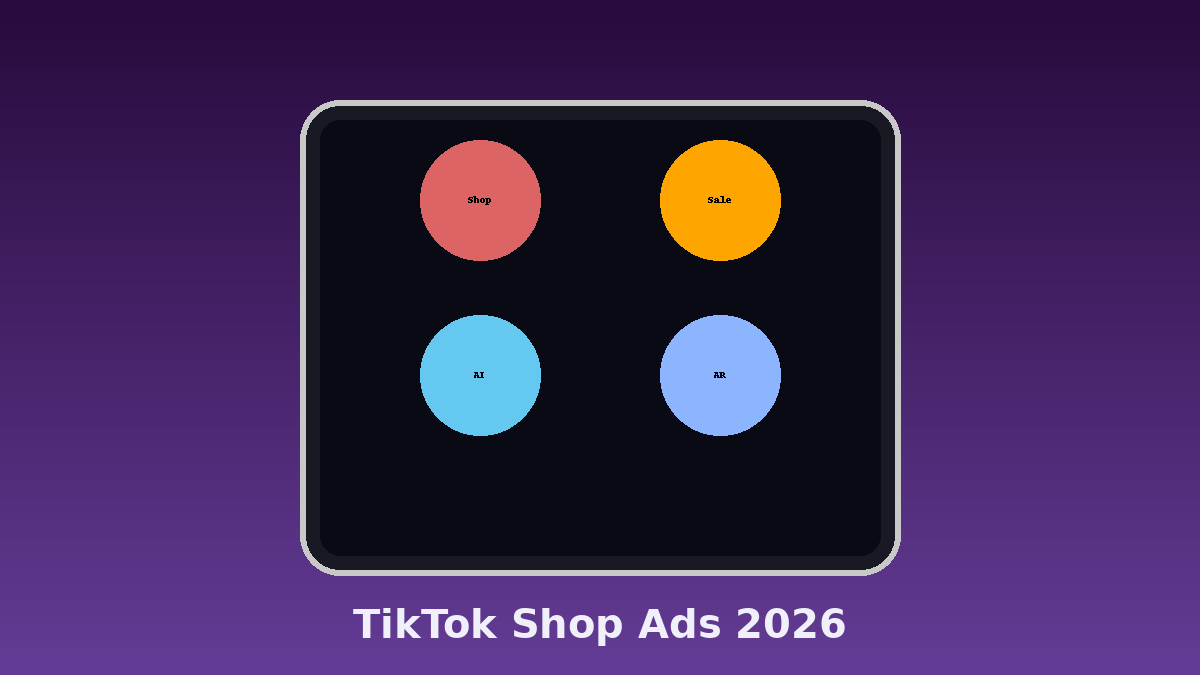Step-by-Step Guide to Running Profitable TikTok Shop Ads in 2026

Introduction
In 2026, social commerce isn't a buzzword—it's mainstream. eMarketer projects that U.S. social commerce will reach $100 billion, and globally, social commerce is expected to represent over 17% of online sales. TikTok Shop sits at the heart of this boom; Hootsuite predicts that 45.5% of U.S. TikTok users will buy through the app. The platform is already addictive; AMZScout notes that 58% of TikTok users shop directly on the platform—that’s more than one billion global shoppers and about 70 million U.S. shoppers. Sales are surging: U.S. TikTok Shop purchases are expected to grow from 24 million in 2022 to 40 million by 2026. If you're not harnessing TikTok Shop ads, you're missing a massive revenue opportunity.
Step 1: Understand TikTok Shop & Social Commerce
Start by grasping how TikTok Shop works and why social commerce matters. TikTok Shop integrates with the TikTok app to let users browse, add to cart and purchase without leaving the video feed. Social commerce collapses the marketing funnel; you can entertain, inspire and sell in one place. In 2026, ad costs will keep rising, so you need creative that cuts through the noise. Understand the unique features: product showcases, LIVE shopping, shoppable tags and affiliate programs. Familiarize yourself with TikTok's Seller Center and community guidelines.
Step 2: Set Up Your TikTok Shop & Business
To run TikTok Shop ads, you first need a verified seller account. Register your business through the TikTok Seller Center, submit business documents and bank details, and complete platform onboarding. Next, create product listings with high-resolution images, compelling descriptions and competitive pricing. Use TikTok’s product template to ensure your listing meets guidelines. Connect your logistics provider and set shipping and return policies. Finally, test the user experience by making a small purchase yourself—you’ll gain insights into how your customers interact with your store and catch any friction points.
Step 3: Research Your Audience & Choose Products
Success starts with product–audience fit. TikTok’s shopper base skews young: more than a third of Generation Z and young millennials use TikTok as a primary shopping channel, and female Gen Z users make a higher percentage of purchases than males. Beauty and fashion items dominate sales, but trending niches like home gadgets, skincare and quirky impulse buys also perform well. Use TikTok’s analytics tools to identify trending hashtags (for example, #TikTokMadeMeBuyIt) and monitor user comments to see what people are discussing. Keep in mind that 60% of TikTok users use the platform as a source for shopping inspiration and 56% of U.S. buyers in 2022 made a purchase after seeing a TikTok ad. Choose products that spark curiosity, have strong visual appeal and fit your target demographic.
Step 4: Create Authentic Ads & Storytelling
In 2026, the era of slick, overpriced ads is over — authenticity sells. Rising ad costs mean creative is the key differentiator. Micro-stories are your secret weapon: weave brand narratives that show a problem–solution arc in 15‑60 seconds. Use the first three seconds to hook viewers with humor, curiosity or bold statements; then address a pain point and demonstrate your product in action. Keep videos vertical and raw—unpolished clips convert better than cinematic productions. End with a clear call-to-action (CTA) encouraging viewers to tap the product link or visit your Shop tab. Always include captions and on-screen text for silent viewing, and test multiple hooks to find what resonates.
Step 5: Leverage Influencers & Affiliate Programs
Influencer marketing drives purchases on TikTok: 78% of users say creators inspire them to buy. Partner with micro-influencers in your niche (10k–100k followers) who have an engaged audience and align with your brand values. Provide them with unique discount codes or affiliate links to track conversions. Encourage them to create authentic unboxing videos, tutorials or lifestyle stories featuring your product. You can also recruit affiliates through TikTok's Creator Marketplace or third‑party networks. Offer tiered commissions to motivate top performers and use their content as paid ads for broader reach.
Step 6: Use AI & AR Tools
AI and AR are transforming social commerce. TikTok’s recommendation engine uses AI to personalize feeds; by layering your ads with AI-driven targeting, you can reach the right audience at the right time. Use TikTok’s Smart Optimization to automatically adjust bids and budgets based on performance. Experiment with AR try-on effects; they let shoppers virtually try products like cosmetics, glasses or clothing, increasing confidence and reducing returns. Chatbots and AI-powered customer service tools can handle inquiries 24/7. Tools like Jasper or Copy.ai help you brainstorm ad copy variations, while video editing apps like CapCut and InVideo use AI to add captions, transitions and effects quickly.
Step 7: Targeting & Analytics
A successful TikTok Shop campaign isn’t ‘set it and forget it’—it requires continuous optimization. Start by choosing the right campaign objective (for example, conversions or catalog sales), then use broad targeting to let TikTok’s algorithm find high-intent shoppers. After gathering data, refine by interests, behaviors, device type and location. Retarget viewers who engaged but didn’t purchase with follow-up videos or special offers. Use TikTok Shop’s analytics dashboard to track metrics like view-through rate, click-through rate, cost per acquisition and return on ad spend (ROAS). Conduct A/B tests on hooks, captions, music and CTAs, and allocate budget to top performers. Analyze UTM parameters in your web analytics to understand customer journeys across platforms.
Conclusion
TikTok Shop ads offer one of the most compelling opportunities in 2026’s social commerce landscape. By understanding the platform, setting up a professional shop, researching your audience, telling authentic stories, partnering with influencers, leveraging AI/AR tools and optimizing with analytics, you can build profitable campaigns that resonate with modern shoppers. As social commerce continues its explosive growth, brands that master these strategies will stand out from the crowd. Ready to take your TikTok Shop to the next level? Explore SocialFansGeek’s AI-powered tools and resources to boost your social media success.
